Punjab rolls out anti-smog strategy
Mitigation model aims for long-term environmental sustainability

The Punjab government, recognising the urgency of the smog situation, has initiated a comprehensive action plan dubbed the "SMOG Mitigation Model 2.0."
The government consulted with experts to develop this robust plan, inspired by the successful dengue elimination efforts of the previous PML-N-led government. The plan aims to address the complex causes of smog through a multi-sectoral approach.
Senior Minister Marriyum Aurangzeb emphasised the intricate nature of the smog problem, noting that it involves various contributing factors beyond smoke-emitting vehicles.
"We needed a joint action plan and collaboration from multiple sectors. The smog mitigation plan has been institutionalized within the Planning and Development Department of Punjab," she stated.
The Environment Protection and Climate Change Department of Punjab (EPCCD) is leading the execution of this plan, launching a crackdown on violators of environmental regulations.
EPCCD's strategy includes strict measures against conventional brick kilns, crop residue burning, smoke-emitting vehicles, industries emitting hazardous gases, and individuals burning garbage or rubber.
EPCCD Secretary Raja Jahangir Anwar highlighted the department's focus on a multi-pronged strategy, calling for active public participation.
"The campaign to combat smog began in early July and will continue until September. We aim to greet the smog-impacted months from October onwards with joint action from both the public sector and citizens," he said.
“Punjab, particularly Lahore has been grappling with a severe smog crisis, which has reached the level of an environmental catastrophe,” he pointed out.
“This toxic layer of smog, often likened to a virus, continues to wreak havoc on both the environment and public health.”
In addition to enforcement actions, the Punjab Government is providing alternatives to facilitate a sustainable transition to environmentally safe practices.



















COMMENTS
Comments are moderated and generally will be posted if they are on-topic and not abusive.
For more information, please see our Comments FAQ